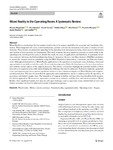Mostrar o rexistro simple do ítem
Mixed reality in the operating room: a systematic review
| dc.contributor.author | Magalhaes, Renato | |
| dc.contributor.author | Oliveira, Ana | |
| dc.contributor.author | Terroso, David | |
| dc.contributor.author | Vilaça, Adélio | |
| dc.contributor.author | Veloso, Rita | |
| dc.contributor.author | Marques, António | |
| dc.contributor.author | Pereira-Loureiro, Javier | |
| dc.contributor.author | Coelho, Luís | |
| dc.date.accessioned | 2024-09-19T09:11:58Z | |
| dc.date.available | 2024-09-19T09:11:58Z | |
| dc.date.issued | 2024-08-15 | |
| dc.identifier.citation | Magalhães, R., Oliveira, A., Terroso, D. et al. Mixed Reality in the Operating Room: A Systematic Review. J Med Syst 48, 76 (2024). https://doi.org/10.1007/s10916-024-02095-7 | es_ES |
| dc.identifier.issn | 1573-689X | |
| dc.identifier.uri | http://hdl.handle.net/2183/39117 | |
| dc.description | Review | es_ES |
| dc.description.abstract | [Abstract] Mixed Reality is a technology that has gained attention due to its unique capabilities for accessing and visualizing information. When integrated with voice control mechanisms, gestures and even iris movement, it becomes a valuable tool for medicine. These features are particularly appealing for the operating room and surgical learning, where access to information and freedom of hand operation are fundamental. This study examines the most significant research on mixed reality in the operating room over the past five years, to identify the trends, use cases, its applications and limitations. A systematic review was conducted following the Preferred Reporting Items for Systematic Reviews and Meta-Analysis (PRISMA) guidelines to answer the research questions established using the PICO (Population, Intervention, Comparator and Outcome) framework. Although implementation of Mixed Reality applications in the operations room presents some challenges, when used appropriately, it can yield remarkable results. It can make learning easier, flatten the learning curve for several procedures, and facilitate various aspects of the surgical processes. The articles’ conclusions highlight the potential benefits of these innovations in surgical practice while acknowledging the challenges that must be addressed. Technical complexity, equipment costs, and steep learning curves present significant obstacles to the widespread adoption of Mixed Reality and computer-assisted evaluation. The need for more flexible approaches and comprehensive studies is underscored by the specificity of procedures and limited samples sizes. The integration of imaging modalities and innovative functionalities holds promise for clinical applications. However, it is important to consider issues related to usability, bias, and statistical analyses. Mixed Reality offers significant benefits, but there are still open challenges such as ergonomic issues, limited field of view, and battery autonomy that must be addressed to ensure widespread acceptance. | es_ES |
| dc.language.iso | eng | es_ES |
| dc.publisher | Springer Nature | es_ES |
| dc.relation.uri | https://doi.org/10.1007/S10916-024-02095-7 | es_ES |
| dc.rights | Creative Commons Attribution 4.0 International License (CC-BY 4.0) | es_ES |
| dc.rights.uri | http://creativecommons.org/licenses/by/4.0/ | * |
| dc.subject | Mixed reality | es_ES |
| dc.subject | Medical remote assistance | es_ES |
| dc.subject | Extended reality, augmented reality | es_ES |
| dc.subject | Operating rooms | es_ES |
| dc.subject | Surgery | es_ES |
| dc.title | Mixed reality in the operating room: a systematic review | es_ES |
| dc.type | info:eu-repo/semantics/article | es_ES |
| dc.rights.access | info:eu-repo/semantics/openAccess | es_ES |
| UDC.journalTitle | Journal of Medical Systems | es_ES |
| UDC.volume | 48 | es_ES |
| dc.identifier.doi | 10.1007/S10916-024-02095-7 |






